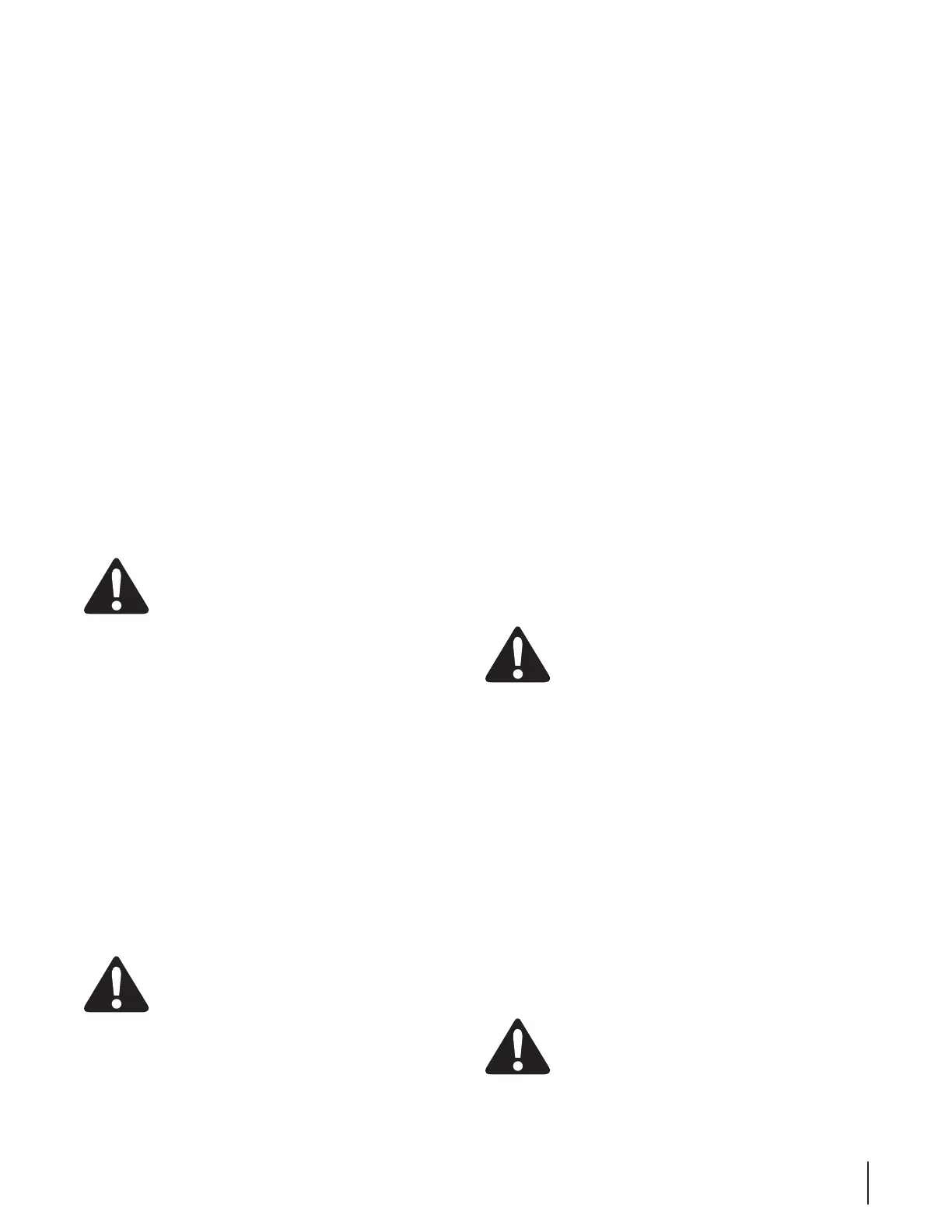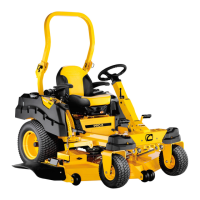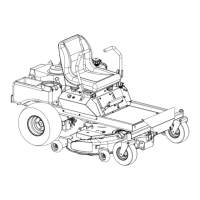5Section 2 — important Safe operation practiceS
2. Use care when loading or unloading machines onto trailers
and trucks.
3. If ramps are used, they must be full width, stable, have an
adequate capacity rating and be secured to the trailer or
truck. Ramp angle should not exceed 15 degrees and trailer
or truck should be parked on level terrain.
4. Machines must be secured onto trailers and trucks with
straps, chains, cables, ropes, or other means deemed
adequate for that purpose. The front and rear of the
machines must be secured to the trailer or truck in both the
lateral and vertical directions.
Operator Protective System (OPS)
1. This machine is equipped with an Operator Protective
System (OPS), which includes:
a. A Roll Over Protective Structure (ROPS) of the fixed
or folding configuration.
b. Seat belt assembly with retractable function.
2. ROPS are structures designed to provide a crush-resistant
space for the operator when properly seat-belted within
the designated seating area of the machine in the event of
a machine tip-over or roll-over. Folding ROPS shall be used
in their fully upright and locked configurations except in
those circumstances whereby they need to be momentarily
folded-down to avoid contact with items such as tree
limbs, clothes lines, guy wires, utility poles, buildings, etc.
At other times and conditions, ROPS shall be in their fully
upright and locked configurations.
DANGER: Damaged ROPS must be replaced
prior to operator use!
3. Seat belts shall be used and shall be properly fastened
about the operator’s waist at all times, except when the
ROPS are:
a. Not properly installed and/or not properly secured
onto the machine.
b. Damaged in such manner that their structural
integrity has been compromised.
c. Not in their fully upright and locked position.
4. Seat belts are attached to the movable portion of the seat
when suspension seats are utilized, and therefore the seat-
mounting base must be secured to its pivot means and the
pivot means latched to the frame of the machine. Seat belts
are attached to the seat or the frame of the machine when
non-suspension (standard) seats are provided, however, if
a suspension kit is added to a seat, the seat belt must be
attached to the movable portion of the seat or suspension
mechanism, the seat-mounting base must be secured to its
pivot means, and the pivot means be latched to the frame
of the machine.
DANGER: If ROPS are folded down or missing,
seat belts shall not be fastened. Worn or damaged
seat belt assemblies must be replaced prior to
operator use.
5. A brush guard or canopy may deflect tree limbs, clothes
lines, and other obstacles that otherwise could come in
contact with the ROPS. Contact of ROPS and/or canopies
by items such as tree limbs, clothes lines, guy wires, and
buildings, could create hazardous conditions whereby
the machine could experience a tip-over or roll-over. A
canopy may provide protection for the operator from some
environmental exposure (sunlight, rain, etc.).
6. The ROPS and seat belt are integral parts of this machine
and should not be tampered with, modified in any manner,
or removed.
7. Inspect the ROPS and seat belt assemblies on a regular
basis for damage and improper operation. Replace all
components that are damaged or are not functioning
properly with authorized replacement parts.
8. The ROPS extends above and behind the operator position,
and therefore the operator must be aware of potential contact
of the ROPS with items such as trees, buildings, doorways,
clothes lines, utility wires, etc., that could cause the machine to
tip-over or rollover. Use caution in (or avoid) areas where the
ROPS could come in contact with any structures, trees, etc.
9. Inspect the ROPS and seat belt assemblies on a regular
basis for damage and improper operation. Replace all
components that are damaged or are not functioning
properly with authorized replacement parts.
10. Failure to use the seat belt properly could result in serious
injury or death if an accidental overturn occurs. In order
for the ROPS to be effective, the seat belt must be securely
fastened around the operator at all times when the
operator is on the machine. Contact with the ROPS during
an overturn could cause serious injury or death.
11. The ROPS will not prevent machine from tip-overs or roll-overs.
12. Do not assume ROPS will protect you in a tip-over or roll-
over. Injuries may still occur.
Hydraulic Devices and Systems
Hydraulic fluid escaping under pressure may have sufficient
force to penetrate skin and cause serious injury. If foreign fluid is
injected into the skin or eyes, see immediate medical attention or
gangrene and permanent damage may result.
WARNING: Keep body and hands away from
pinholes or nozzles that could inject hydraulic fluid
under high pressure. Use paper or cardboard, not
your hands, to search for leaks! Wear gloves and
safety glasses.
Safely relieve all pressure in the system before performing any
work on the system, and make sure that:
• The ignition switch is OFF
• The key is removed
• The engine spark plug wire(s) removed
• All connections to the negative terminal of the battery are
removed
• The park brake is set
• All by-pass valves, if so equipped, are open
• Hydraulic controls are actuated to release pressure on
pumps, cylinders, etc. If “float” positions are available, they
should be used.
After the above operations are completed, it should be safe to
begin disconnecting the lines or components. It is still a good
idea to cover the connection with a cloth shield and then gently
loosen connections.
WARNING: Make sure all hydraulic fluid
connections are tight and all hydraulic hoses and
lines are in good condition before applying pressure
to the system.

